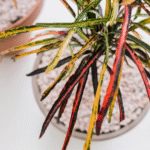The Ti plant, also known as the Good Luck Plant, is a tropical beauty with colorful, eye-catching leaves. Its scientific name is Cordyline fruticosa, and it is known for bringing good luck and positive energy, especially in Hawaiian and Asian cultures. With bright shades of green, red, pink, or purple, the Ti plant adds a tropical feel to any space—indoors or outdoors.
Even though it looks exotic, the Ti plant is fairly easy to grow if you give it the right care. In this guide, we’ll walk you through everything you need to know to grow and care for this beautiful plant in simple, clear steps.
What Makes the Ti Plant Special
The Ti plant stands out because of its colorful, shiny leaves that grow in a rosette shape at the top of tall canes. Some varieties are green, while others are bright red, pink, or even have mixed colors. This plant is also believed to bring luck, happiness, and protection to your home or garden.
It grows well as a houseplant, in containers, or outdoors in warm climates. Because of its tropical nature, it needs warmth, light, and moisture—but once you meet these needs, it will reward you with vibrant, long-lasting beauty.
Choosing the Right Spot
The Ti plant needs bright, indirect light to keep its leaf color strong. If you grow it indoors, place it near a window where it gets lots of filtered light but not direct sunlight. Too much sun can burn the leaves, while too little light can make the colors fade.
If you grow it outdoors, pick a spot with partial shade. In tropical areas, the Ti plant can grow in full sun, but in very hot places, some afternoon shade is helpful.
Avoid cold or drafty areas, as Ti plants don’t like sudden changes in temperature.
The Best Soil for Ti Plant
Ti plants grow best in well-draining soil that holds some moisture but doesn’t stay soggy. A good potting mix for tropical plants or houseplants will work well. You can also mix regular potting soil with perlite or sand to improve drainage.
If you’re planting it in the ground outdoors, make sure the area doesn’t flood or stay wet for long after rain. Wet roots can cause rot and damage the plant.
How to Plant a Ti Plant
If you’re planting your Ti plant in a pot, choose a container with drainage holes. This keeps the water from sitting at the bottom and causing root rot.
Place a layer of small stones or gravel at the bottom of the pot if you want to improve drainage. Fill the pot with your soil mix, and plant the Ti so the roots are covered and the base is level with the soil surface. Press the soil gently and water lightly after planting.
For outdoor planting, dig a hole a little wider than the root ball, place the plant in the hole, and fill in with soil. Water well to help the roots settle in.
Watering Tips
Ti plants like to stay slightly moist, but not wet. Water the plant when the top inch of soil feels dry to the touch. In warmer months, you may need to water more often, especially if the plant is outside or in bright light.
Reduce watering in the cooler months when the plant’s growth slows down. Always avoid letting the soil stay soggy, as this can lead to root rot.
Ti plants are sensitive to chemicals in tap water, especially fluoride and chlorine. If possible, use filtered water or let tap water sit out overnight before using it.
Temperature and Humidity
Ti plants are tropical, so they prefer warm, humid air. The ideal temperature is between 65°F and 85°F (18°C to 29°C). They do not like temperatures below 50°F (10°C). If the air is too cold, the plant may lose leaves or stop growing.
Indoors, try to keep your Ti plant away from cold windows, air conditioning vents, or heaters. For extra humidity, you can mist the leaves, use a humidifier, or place a tray of water and pebbles under the pot.
Fertilizing
To keep your Ti plant healthy and colorful, feed it with a balanced liquid fertilizer every 4 to 6 weeks during the growing season (spring through early fall). Use a fertilizer made for houseplants or tropical plants, and follow the label directions.
Avoid over-fertilizing, which can burn the roots or cause leaf edges to turn brown. If your tap water has fluoride or salt buildup, flush the soil every couple of months by running water through the pot and letting it drain fully.
Pruning and Cleaning
Pruning helps your Ti plant look its best and encourages new growth. If the lower leaves turn yellow or brown, simply trim them off near the base. You can also cut back long, bare stems to shape the plant or make it bushier.
Wipe the leaves with a damp cloth every few weeks to remove dust and keep the plant looking shiny and fresh. Clean leaves also absorb more light, which helps the plant grow better.
Propagation: Growing More Ti Plants
Ti plants are easy to multiply through stem cuttings. To do this, cut a healthy stem into sections that are 4 to 6 inches long. Each piece should have at least one “node,” which is a small bump where leaves or roots can grow.
Lay the cuttings flat in moist soil, or plant them upright with one end in the soil. Keep the soil slightly damp and place the pot in a warm, bright spot. Roots and new leaves should start to grow in a few weeks.
You can also grow Ti plants from the top of a cane or from suckers (small shoots) that grow at the base of the plant.
Common Problems and How to Fix Them
Ti plants are generally easy to care for, but they can have a few problems:
Brown leaf tips or edges – This is often caused by dry air, over-fertilizing, or fluoride in tap water. Try using distilled water and misting the plant more often.
Yellowing leaves – This can happen from too much water, not enough light, or poor drainage. Check the soil and move the plant to a brighter spot if needed.
Leaf drop – Sudden changes in temperature, drafts, or stress can cause leaves to fall off. Keep the plant in a stable, warm environment.
Pests – Common pests include spider mites, mealybugs, and aphids. Wipe them off with a damp cloth or spray the plant with insecticidal soap.
Using Ti Plant in the Garden or Home
Ti plants are great for both indoor and outdoor use. Indoors, they add color and life to living rooms, hallways, or bright bathrooms. Outdoors, they make beautiful tropical borders, hedges, or potted accents on patios.
You can mix Ti plants with other tropicals like hibiscus, crotons, or elephant ears. Just make sure all the plants have similar needs for light and water.
In Hawaiian culture, Ti leaves are used in decorations, leis, and even cooking. The plant is also believed to protect homes and bring peace and good luck.
Is Ti Plant Safe for Pets?
Ti plants are not safe for pets if eaten. The leaves can cause stomach upset, vomiting, or drooling in cats and dogs. If you have pets that like to chew plants, it’s best to keep your Ti plant out of reach or choose pet-safe plants instead.
Final Thoughts
The Ti plant is a colorful and cheerful plant that can brighten any space. With its rich, tropical leaves and strong growth, it adds beauty, warmth, and even good luck to your home or garden. Best of all, it’s not hard to care for once you understand its needs.
Give your Ti plant warmth, light, moisture, and a little love, and it will reward you with bold color and lush leaves all year long. Whether you’re a beginner or a plant lover, the Ti plant is a great addition to your green family.







Leave a Reply